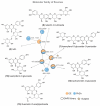Antibacterial Activity from Momordica charantia L. Leaves and Flavones Enriched Phase
- PMID: 36145544
- PMCID: PMC9505480
- DOI: 10.3390/pharmaceutics14091796
Antibacterial Activity from Momordica charantia L. Leaves and Flavones Enriched Phase
Abstract
Momordica charantia L. (Cucurbitaceae) is a plant known in Brazil as "melão de São Caetano", which has been related to many therapeutic applications in folk medicine. Herein, we describe antibacterial activities and related metabolites for an extract and fractions obtained from the leaves of that species. An ethanolic extract and its three fractions were used to perform in vitro antibacterial assays. In addition, liquid chromatography coupled to mass spectrometry and the molecular networking approach were used for the metabolite annotation process. Overall, 25 compounds were annotated in the ethanolic extract from M. charantia leaves, including flavones, terpenes, organic acids, and inositol pyrophosphate derivatives. The ethanolic extract exhibited low activity against Proteus mirabilis (MIC 312.5 µg·mL-1) and Klebsiella pneumoniae (MIC 625 µg·mL-1). The ethyl acetate phase showed interesting antibacterial activity (MIC 156.2 µg·mL-1) against Klebsiella pneumoniae, and it was well justified by the high content of glycosylated flavones. Therefore, based on the ethyl acetate phase antibacterial result, we suggest that M. charantia leaves could be considered as an alternative antibacterial source against K. pneumoniae and can serve as a pillar for future studies as well as pharmacological application against the bacteria.
Keywords: antibacterial activity; dereplication; glycosylated flavones; molecular networking.
Conflict of interest statement
We declare no current or potential conflict of interest related to this article.
Figures




References
-
- Who No Time to Wait: Securing the Future from Drug-Resistant Infections. [(accessed on 31 December 2020)]. Available online: https://www.who.int/antimicrobial-resistance/interagency-coordination-gr...
-
- O’Neill J. Tackling Drug-Resistant Infections Globally: Final Report and Recommendations. The Government of the United Kingdom; London, UK: 2016.
-
- Ali Mirza S., Afzaal M., Begum S., Arooj T., Almas M., Ahmed S., Younus M. Chapter 11-Uptake Mechanism of Antibiotics in Plants. In: Hashmi M.Z., editor. Antibiotics and Antimicrobial Resistance Genes in the Environment. Volume 1. Elsevier; Amsterdam, The Netherlands: 2020. pp. 183–188.
-
- Michelin D.C., Moreschi P.E., Lima A.C., Nascimento G.G.F., Paganelli M.O., Chaud M.V. Avaliação da atividade antimicrobiana de extratos vegetais. Rev. Bras. Farmacogn. 2005;15:316–320. doi: 10.1590/S0102-695X2005000400010. - DOI
-
- Guarniz W.A.S., Canuto K.M., Ribeiro P.R.V., Dodou H.V., Magalhaes K.N., Sá K., do Nascimento P.G.G., Silva K.L., Sales G.W.P., Monteiro M.P., et al. Momordica Charantia L. Variety from Northeastern Brazil: Analysis of Antimicrobial Activity and Phytochemical Components. Pharmacogn. J. 2019;11:1312–1324. doi: 10.5530/pj.2019.11.203. - DOI
Grants and funding
LinkOut - more resources
Full Text Sources
Molecular Biology Databases

